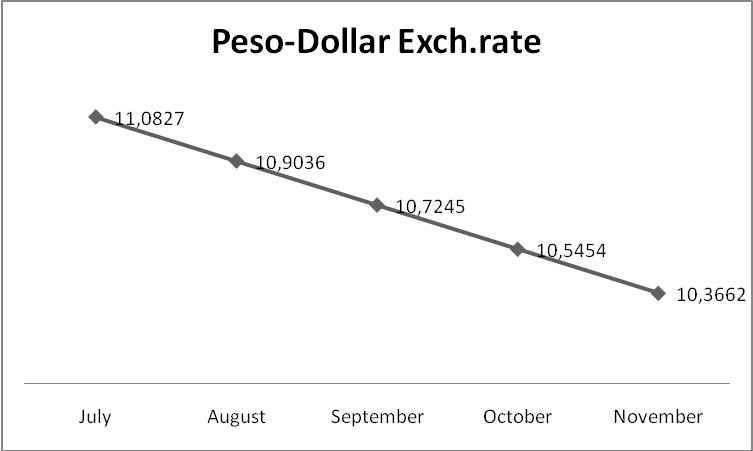The United Mexican States is selected for the current review. The choice is motivated by the fact, that it is one of the closest neighboring countries with the USA.
Peso – the national currency of UMS. It has almost the same symbol as the US dollar has ($). It is divided into 100 centavos.
The exchange rate for the peso is 0.096893 U.S. dollars (June 2008)
Exchange rate changes (July 2007 – November 2007)

Examinations for the essential form of trend-following performance do not find that past replacement rate movements expect how entrepreneurs change their net locations, with the exemptions of the US dollar and the Mexican Peso. Nevertheless, a closer assessment of these two currencies proposes that the statistical power of the relations is not evocative. Regressions of modifications in net locations on lagged exchange rate modifications and net position changes yield very small for the dollar and for the Mexican Peso, meaning that very little about modifications in net position can be featured to past exchange rate changes.
There are only a few matters that cause more inquisitiveness and provide more inquiries than the behavior over time of a major exchange rate such as that between the peso and the dollar. As lots of business executives have maintained over the years, the peso apparently confronts quantitative finances, financial market, political stadium, and literary examination. While that declaration, born out of years of peso-examination and occasional currency market defeats, maybe partially precise much of the time, it does not permit business experts or economists the luxury of walking away from this market matter and viewer activity.
The performance of the peso/dollar exchange rate has been mainly interesting to observe in 2006 and 2007. For that period, the monthly regular nominal exchange rate has vacillated in a comparatively tight band amid P/$ 10.48 and P/$ 11.39. In fact, the monthly average supposed exchange rate has not broken either P/$ 10 or the P/$ 12 from September 2007 onward. Given everything that has occurred during that period, plus an inflationary gap between the two financial systems that still perseveres, such constancy is somewhat astonishing.
Offered the financial market instability and financial indecision that has been scrutinized during the required period, it is no revelation that the peso has withdrawn somewhat in supposed terms. Basic oil changes seem to have leveled off at less than $75 per barrel and emerge subject to more problems than advantage risks. Prospects for the different stock market indices are not much variety, with commercial productivity in the United States restrained by a reasonably weak commerce cycle viewpoint.
One component that might originate further peso gains against the dollar is possible for descending changes in north-of-the-border interest acquiesces if their complements in Mexico hold stable. Another is ongoing straight foreign investment investments. Aside from those opportunities, some supposed depreciation for the peso would not come as a surprise. Whether such an expansion will go far enough to remove the progressive real exchange approval of the peso stays to be regarded.
References
Carlos-Mendez, Julio, “Sources of Real Exchange-Rate Fluctuations: Empirical Evidence from Four Pacific Basin Countries.” Southern Economic Journal 63.3 (2007): 776.
Chinn, Menzie, and Jeffrey Frankel. “Patterns in Exchange Rate Forecasts for Twenty-Five Currencies.” Journal of Money, Credit & Banking 26.4 (2007): 759.
Engel, Charles, and Marco A. Espinosa-Vega. “Optimal Exchange Rate Policy: The Influence of Price Setting and Asset Markets.” Journal of Money, Credit & Banking 33.2 (2007): 518.
Miller, Kent D., and Jeffrey J. Reuer. “Firm Strategy and Economic Exposure to Foreign Exchange Rate Movements.” Journal of International Business Studies 29.3 (2007): 493.